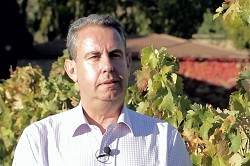A wheeled robot to monitor grape growth
Today, assessing the readiness of vine grapes for harvesting requires growers to sample hundreds of berries, with their eyes as the only tool they can rely on. With VINEROBOT’s (VINEyardROBOT) technology, they can now look forward to the day when this tiresome work will be facilitated by a robot able to estimate future grape yield, monitor plant growth, as well as assess water status and berry composition, with all that information being made available on their smartphone or tablet. Now with its second prototype, the VINEROBOT team has recently been granted a six-month project extension to complete its work. Dr Javier Tardaguila, coordinator of the project, discusses the benefits of this technology and his hopes for great success within the wine grower community. What are the benefits of VINEROBOT’s approach compared to alternatives? Recently, various remote sensing solutions from aerial platforms or satellites have been enhanced with simultaneous acquisition of spectral information in the visible and infrared ranges, allowing for the assessment of grapevine vigour and water status. But the small spatial resolution of multispectral devices, the discrete architecture of grapevine cultivation in rows rather than bulk crop, limited weather flexibility and the elevated cost of aerial monitoring, are major drawbacks which have forced small and medium-sized European vineyards to discard remote sensing altogether. VINEROBOT is a promising alternative: It will provide reliable information using proximal sensors on-the-go in a non-invasive way, in different types of soils, and in a more cost-effective process that can be used across a wide range of vineyards. What would you say are the most innovative aspects of VINEROBOT’s UGV? Rational decision-making in sustainable viticulture requires objective and continuous key parameter monitoring by means of advanced technologies and sensors in the field. But currently there are no commercial products that can simultaneously map key parameters such as agronomical, physiological and fruit composition on-the-go. Data sampling is being carried out manually, which implies high costs and low resolution, and is usually influenced by the interpretation of the person involved. By designing, developing and deploying an agricultural robot in the shape of a UGV, and equipping this robot with several non-invasive sensing technologies to monitor the likes of grapevines’ vegetative growth, nutritional status and grape composition, VINEROBOT aims to bridge this gap. Our goal is to optimise vineyard management, as well as improve grape composition and wine quality. What tasks can this robot perform? The VineRobot is equipped with non-invasive advanced sensors and artificial intelligence systems, to provide reliable, fast and objective information on the state of the vineyards to grape growers. Thanks to these technologies, VineRobot will be able to work — that is, retrieving agronomical and physiological data from the grapevines — autonomously and safely over long periods of time under the uncertain environmental conditions typically found in vineyards. The first version of the VineRobot incorporates a fluorescence-based sensor to assess nitrogen content in leaves. The measurement is performed on-the-go and provides information about the heterogeneity and state of the vineyard. The other sensor included in the VineRobot measures the anthocyanin content in grapes. This sensor is a fusion between a fluorescence sensor and a fine vision system: It gathers information about the composition of grape berries. A second version of the VineRobot is already foreseen. It is expected to include two additional sensors: one for yield assessment and one to control vineyard water status. What has been the sector’s feedback so far? Grape growers that have seen the VineRobot have shown a high level of interest, especially young grape growers (younger than 45 years of age), because they are often more open-minded regarding new technologies. However, in the long term it is expected that older viticulturists will also consider using our robot, once they witness the good results brought in other vineyards. What can they expect in terms of concrete benefits? The VineRobot works alone, without the need for any human presence. Moreover, working speed can be adjusted depending on the size of the vineyard, so that the robot can obtain information about the whole vineyard easily and in a short period of time, whilst providing useful maps to vine growers. These maps of wine parameters can help them with how to best treat the crop. For example, they can plan for a more precise mechanical harvesting or fertilisation, which will have a huge influence on the yield and the wine’s quality. When do you expect your solutions to be commercialised? We are still developing and completing the VineRobot, improving its latest version. We don’t really know when it will be ready, but we expect that the product could be commercialised next year. VINEROBOT Funded under FP7-ICT project website
Countries
Spain



